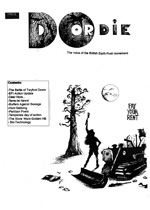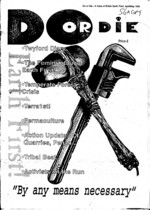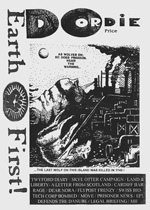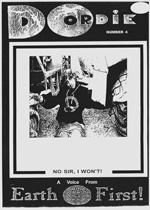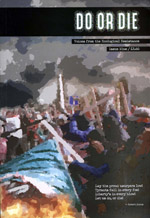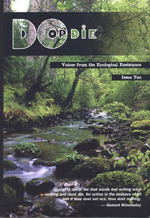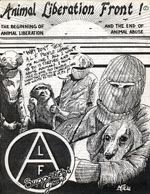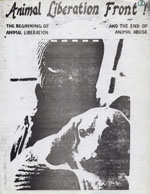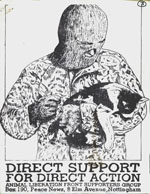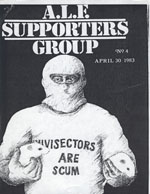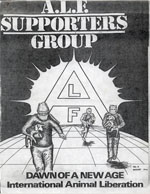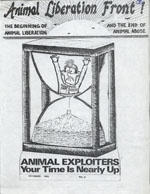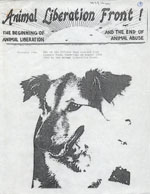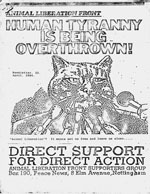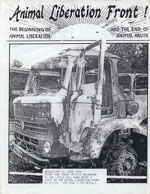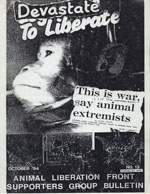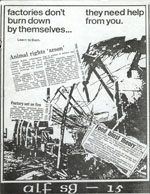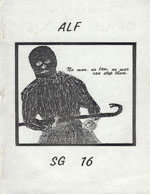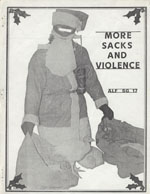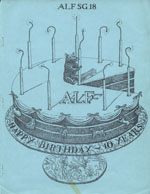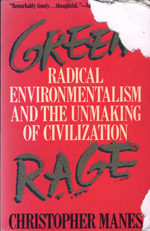The Archives
-
Do or Die, Most Popular, Periodicals
Do or Die – The Complete Set!
04.09.14 | PermalinkDo Or Die #1-10 (1993-2003, Brighton, England.)
A few years ago a friend asked me if I had a complete set of Do or Die, the British Earth First! publication that inspired and incited eco-warriors throughout the 1990s and early 2000s. At one time I did have them, but they had long since been stolen by a Joint Terrorism Task Force.
After a brief discussion, we decided that Do or Die was too important to fade into obscurity. We began tracking down each issue, and decided that while we were at it we ought to archive some other publications as well. That effort is how this web site began, and now, thanks to 56a infoshop of South London and Tim @ NEDS Northampton, we can finally share the very rare issue #2. This completes our collection, and our original mission as well.
When read as a set, Do or Die is a chronicle of people from across the globe counter-striking capitalism, ecocide, and the state. Each issue is better than the last, but more importantly, each page is a spark licking at the fuse of the bomb that is your heart. Once lit, you’ll know that these pages are not mere history, but a reminder that we can explode onto the world stage like the fighters before us have. Do or die, now is the time to rise.
…
-
Do or Die, Most Popular, Periodicals
Do or Die #10
06.10.13 | PermalinkDo Or Die #10 (2003, Brighton, England.)
It’s hard to believe that it has been a decade since the Do or Die collective published the final issue of their influential, book sized periodical. This last dispatch screamed the same urgent message as its predecessors: Take action now, or die alongside the rest of humanity in the coming ecological meltdown.
In the ten years since our situation has only become more desperate, and therefore the inciting cries for resistance in the pages of Do or Die have only increased in relevance. Plenty has been written on this site about this publication: that it was our reason for starting TALON, that it was the best environmental publication ever, and so on. None of that will matter if DoD’s message is ignored. Read these pages with an eye towards how you will utilize the lessons contained inside. Then, start making plans to create a better world, and implement those plans quickly, because as the title suggests, if you don’t “Do” than our species has only one other option…
The other issues of Do or Die in our archive can be found HERE.
…
-
Most Popular, Periodicals, The SG (original 80s volume)
The ALF Supporters Group Newsletter – The complete original set!
03.04.13 | PermalinkThe ALF Supporters Group Newsletter #1-19 (1982-1986. Nottingham / London, England)
When this archive project was founded two years ago, a list was made of the ten publications that we “had to have.” Number one was a complete set of the first volume of “The SG.” This was a tall order, and we knew it. First off, the Animal Liberation Front Supporters Group must be one of the most raided entities in England, and its members were frequently raided themselves! The result was that many copies of the magazine ended up in police custody both before and after distribution, never to be seen again. Second, it was a relatively old newsletter, and since the first issues were mimeographed on cheap paper, finding intact copies was going to be difficult. We persevered though, and now these rare pieces of movement history are preserved digitally and online for everyone to read and learn from.
Started by Dave Nicholls in 1982, the ALF Supporters Group was an effort to do two things: 1.) To raise funds for people arrested for animal related direct actions. 2.) To create a broader base of support for the Animal Liberation Front inside the movement. Both goals were met quickly. Within two weeks of their founding, the Supporters Group hit the number of members they had set as their long term goal. Through direct donations, memberships, fundraising events, and sales of merchandise, the SG was able to contribute towards the sizable legal costs of activists being arrested across England.
The newsletter itself went through varying degrees of quality in writing, layout, and value to the movement. The early days of the Nicholls run may have had a drab interior, but the hand illustrated covers were sometimes gorgeous, and the rhetoric had not yet strayed into the more-militant-than-thou nonsense which came later. Eventually the writing would border on the cultish, but there is scarcely an issue of the magazine that doesn’t have some redeeming value. When read critically and as a whole body of work, this magazine follows the rise and spread of underground action for animals across the globe, illustrates the value of coalition building, and provides solid examples of extremism to be avoided through coverage of groups like the Animal Rights Militia. It also provides many historical details found nowhere else!
“The SG” has gone through several incarnations since British Law enforcement shut this one down in 1986. (While carrying out the investigation for the notorious Sheffield trial that sent Ronnie Lee to prison for 10 years, the police raided the SG and charged it’s editors with incitement. Everything published by the SG afterwords had to be run past a lawyer first, but this didn’t stop further raids, arrests, and convictions of those involved in the newsletter.) It is still being published today, copies can be ordered from www.alfsg.org.uk.
Finally, an excellent analysis and critique of the SG and the rise of England’s “Cult of Militancy” can be found in the book Against All Odds, available here at the Talon Conspiracy.
…
-
One-off publications
Into The 90s With The ALF / This Is The ALF #2
12.26.12 | PermalinkInto The 90s With The ALF (1991, City Unknown, England)
This Is The ALF #2 (1994, City Unknown, New Zealand)First things first: the posting of these two old ALF publications requires a little uncomfortable honesty. You see, neither zine is particularly well written, the advice given on tactics (and strategy) isn’t particularly insightful, and everything covered inside has been dealt with better elsewhere. However, these were both widely distributed in their time, and as we aim to be a complete archive both of these anonymously distributed tracts deserve a place here on the site.
With that said (or written, as it happens to be!) these zines provide us with a view into the issues and campaigns being discussed by radical animal liberationists during the early 90s. The focus on economic damage versus rescue is particularly interesting, and some might argue resulted in a public relations failure for the movement. Also intriguing is tracking the way the contents traveled around the world to be republished in different countries. Into the 90s carries material originally published in Canada, This Is the ALF has content from the United States and England. The loose network of animal liberation militants that existed prior to the popular use of the internet is fascinating, and imagining how the anonymous authors of these publications received the items they ultimately reprinted is entertaining fodder for the imagination.
All told, these primers were meant to provide newcomers with a quick overview of the Animal Liberation Front, and to spread the use of direct action in their respective countries. They do so, just not in a particularly inspiring manner.
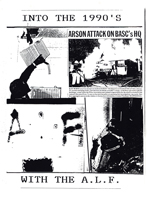

-
Books, Most Popular
Green Rage
12.03.12 | PermalinkGreen Rage: Radical environmentalism and the unmaking of civilization (1990, Boston, MA.)
One of the first books I bought about radical wilderness defense was Green Rage. It is an excellent investigation of the origins of (western) environmental radicalism, and I recommend that you read it cover to cover.
Speaking of covers, you might notice that this particular copy of Green Rage is a little ragged. The reason for that is because this is my copy, and after reading the book I took it’s message to heart. Several years ago in Oregon, a small group of activists from around the region were protesting at a breeding facility that supplied rabbits to the vivisection industry. When we arrived the farms owners were not present, and neither were any law enforcement. Not coincidentally I quickly found myself living with some critters who liked to chew on everything in our humble home. I hope you will enjoy Green Rage as much as they did!
…
-
Most Popular, Periodicals, The Beast
The Beast #1-#10
03.29.12 | PermalinkThe Beast #1-#10 (1979-1981. London, England.)
On the 5th of November of 1947 a baby lowland gorilla, stolen from his home and family in West Africa, arrived at the London Zoo. As it was Guy Fawkes day, this newest prisoner was named in his honor. Guy the Gorilla went on to become one of the biggest money makers for his captors, and thousands of visitors would gawk at him, occasionally throwing him sweets to eat. Eventually the candies rotted his teeth, and during a surgery to repair them, he had a heart attack. The budding animal liberation movement in the UK took notice, and a group of people began producing buttons with Guy’s face on them. As the buttons grew in popularity, this small group decided to make a newspaper, and soon The Beast became an insert in International Times. After two such inserts the editors struck out on their own, and soon this beautiful publication was on newsstand racks in England and abroad. It was produced for two short years, and remains one of the best animal liberation (and anti-nuke!) publications of all time.
The Beast began it’s run during a time of global social and political decay. As the voters of the west fell under the spell of charismatic and brutal conservatives, a broad coalition of anti-nuke, anti-fascist, union, conservationist, environmentalist, and animal lib activists entrenched themselves to fight back. As things “hotted up” in the streets, the staff of the magazine followed the action and ideas of an astonishing number of people and groups. The tone in the early issues is optimistic, brave, and intelligent, and offers a fascinating glimpse into the psyche of activists during the era.
The history covered is equally incredible. Articles offer the story of the first animal liberation raid in the United States, the origins of the Hunt Saboteurs Association, and the early days of the Animal Liberation Front. Lost figures, like OG U.S. Hunt Sab and eco-prisoner John Walker, come back to life in these old pages. Important thinkers, such as Henry Spira, Peter Singer, Richard Adams, and Paul Watson were regular contributors. Then, there are the images! Between the full color, glossy covers are amazing pictures of early raids, movement legends, and epic moments on our movement’s timeline. One such photograph, taken in 1980 and shown in issue #10, captures a small group of Animal Liberation League activists standing with banners in a field, bandannas covering their faces, fists in the air. More than 30 years later young people still show that same spark of rebellion and hope, and with our archiving of this magazine, perhaps they will now better understand the revolutionaries who came before them.
When we started Conflict Gypsy one of our dreams was to obtain a complete set of The Beast. After just one year of existence, we have met this goal. As our birthday gift to you we offer the Complete Newsstand Collection of The Beast, perhaps our most important single posting so far…










-
One-off publications, Videos
Angels of Mercy?
03.22.12 | PermalinkAngels of Mercy? (1995, London, England)
In 1995 Channel 4’s Warcries news program aired Angels Of Mercy?, a 30 minute investigation into the Animal Liberation Front. The show focused primarily on Keith Mann, an ALF volunteer who was then serving England’s longest sentence for animal rights motivated arson. While most commercially funded news has a clear bias in favor of the status quo (and the channels sponsors,) Warcries was known for fairer journalism. The result in this case was a surprisingly sympathetic look at what pushes a young person to commit criminal acts on behalf of non-humans. Given developments since it first aired, it also serves as a remarkable lesson about public credibility and how difficult it is to regain once lost.
In the 1990s our movement had a variety of articulate, savvy spokespeople, and the release of Angels of Mercy? quickly made Keith Mann foremost among them. His voice-overs from a prison phone are heard over shocking footage of animal abuse, and interviews with his family and supporters act to assure the audience that he is a rational and passionate activist working to stop what can only be described as horrific cruelty. When Keith was later released from prison he was highly sought after as a speaker and a source for reporters. I always felt reassured when I saw his face in the news since I knew it meant that at least one positive quote would make it’s way to the public.
Sadly, in the last few years Keith has become a devotee of British new-age guru David Icke, a man who believes that a race of reptilian shape-shifters secretly controls the world, that cancer is a fungus, that some humans are actually half-dead, inter-dimensional beings, and a host of other pseudo-scientific nonsense. After being literally laughed off of television in 1991 when he wrongly predicted the end of the world, he has resurfaced in recent years as a lecturer and author with a depressing number of followers.
Since his conversion to odd-ball conspiracy theorist Keith Mann has lost much of his credibility both inside and outside the movement. Most recently he has become a holocaust denier, thereby severing his ties with many of us who still held some hope that he would come to his senses. It’s a shame, because as I watch Angels of Mercy? I am reminded of the rare power he once had to make everyday people understand direct action and animal liberation, a power whose benefit is now lost to the animal nations. It is my hope that by posting this video others will consider how desperately the animals need trustworthy advocates, and how easy it is to damage that trust.
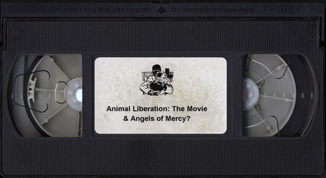
-
Do or Die, Periodicals
Do or Die #7
01.30.12 | PermalinkDo or Die #7 (1998, Brighton, England.)
The genesis of Conflict Gypsy came from our founder’s desire to collect and preserve a complete set of Do or Die, the classic British Earth First! publication. While we still have not found copies of issues 1-4, our posting of these book sized epics continues with issue #7.
Do or Die was always reasonably free of the acritical cheer leading of it’s many American counterparts, and this issue manages an honest examination of the limitations and capabilities of direct action campaigns from Poland to Brazil to Mexico. As always, there is a bittersweet mixture of inspiration and despair while reading about the clashes between the oppressed and the powers of the state and industry, but there are enough victories contained in this volume that elation prevails! You will cheer as the black bloc escapes arrests in Derbyshire by switching into hippie clothing and shouting “no violence” as the police roll in (An activist in England nearly pissed themselves telling me that story one night!) and as wild boars recruit domesticated pigs for non-human resistance to domestication. The power of villagers in India to stop dams lessens the pain of reading about the paramilitary massacres of people in Acteal, and other articles will have you thinking deeply about our movements DIY media efforts, prison support, and coalitions with labor groups. All in all, another must read from one of the most exciting periods of resistance in the 20th century.
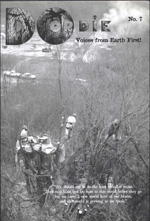
-
Arkangel, Periodicals
Arkangel #4,5,7
01.02.12 | PermalinkArkangel #4,5,7 (1990-1991. London, England)
Our posting of the complete Arkangel continues into the 90s with issues 4, 5, and 7. The omission of issue 6 is not an oversight- it was never printed. Arkangel was founded by Ronnie Lee, who was serving a 10 year sentence during the magazines early years, and edited by Vivien Smith, who found herself in a jail cell by the time issue #6 was scheduled for release. Sensing the possibility of shutting down this crucial publication, law enforcement in England ransacked the Arkangel office just before the layout of issue #6. It was lost to the ages, and with Vivien facing serious charges a new team of interim editors anonymously produced Arkangel #7, causing a slight decline in the publication’s overall quality.
The history covered by these three issues is tremendous. The death of Mike Hill, Animal Aid’s disastrous labeling of direct action as “terrorism,” and the return of the ALF Press Office are all reported upon, along with updates from groups around the world. Amidst the columns reporting on the actual work of activists though is a disturbing amount of debate, much of it centered on whether animal rights groups should allow participation by racists, nationalists, and separatists. The back and forth articles from one issue to the next mostly fail to recognize the most offensive nature of the argument – that there should even be an argument! It boggles the mind that anyone could see a benefit to taking on the baggage of these far right lunatics and their disgusting politics. During a decade where skinhead violence claimed the lives and dignity of so many it is particularly disheartening that some in our movement saw fit to offer these thugs a place at our table.

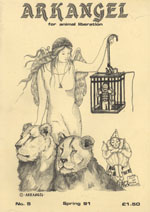

-
Books, Most Popular
Animal Liberation: A Graphic Guide
11.24.11 | PermalinkAnimal Liberation: A Graphic Guide (1987, London, England.)
Published twelve years after Singer’s groundbreaking book, Animal Liberation, this graphic guide is lesser known but still influential. Part of the reason why it is lesser known is that this book is not known for the commentary provided by Prof Singer, or even Prof. Gruen, but instead it’s influence can almost solely be charted to the breath taking artwork done by David Hine.
Although the images in this book have been reprinted countless times, in publications all over the world, little attention in animal liberation circles has ever been paid to Hine the illustrator. Hine was commissioned to do the guide in 1987, alongside another publication critical of the “Space Wars” (Space Wars: A Graphic Guide). The career that Hine would go on to have after 1987 is interesting to say the least. Hine is now considered an iconic British comic artist – with an impressive thirty year independent publication career alongside drawing and/or writing for household name comic series such as; Transformers, X-Men, Spiderman, Spawn and Batman and Robin. Recently, Hine has also made waves in the comic book industry by introducing an Algerian Muslim super hero figure, Nightrunner, in his Dark Knight series that was set in France.
Hine’s impressive career explains the comic-book esque structure of the guide as well as the absolutely amazing skills on display. Twenty four years later and there is simply no comprehensive visual rival to the work of this guide. Conflict Gypsy is beyond excited to host this publication here, to trace and celebrate it’s influence, and to hopefully inspire all of those illustrators/designers/drawists out there currently fighting for animal liberation.

…
